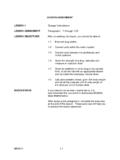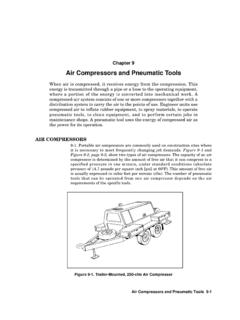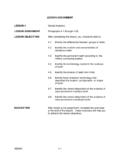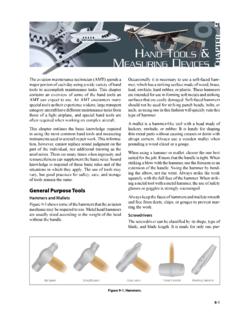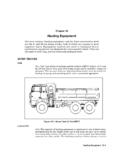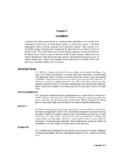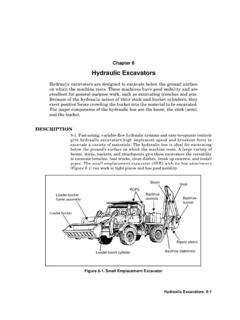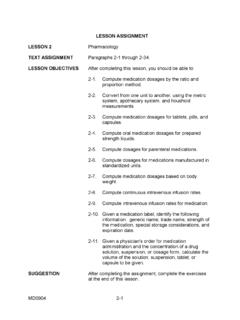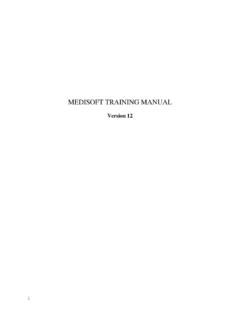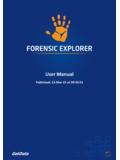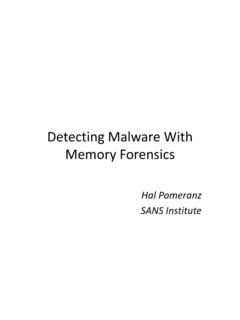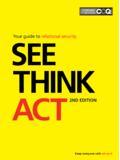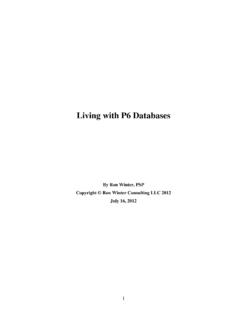Transcription of CHAPTER 2
1 CHAPTER 2 DENTAL EXAMINATIONSINTRODUCTIONPATIENT PREPARATIONThe dental examination is one of the basicprofessional services provided by the Navy dentalteam. Soon after you entered the military service, youreceived your first dental-oral examination todetermine your dental health. Throughout yourservice with the Navy, you will receive annual orperiodic dental examinations. The results of theseexaminations are recorded in your individual Medical Outpatient and Dental TreatmentRecord (NAVMED 6150/21-30). The preparation ofthe NAVMED 6150/21-30 is discussed in DentalTechnician, Volume 1, CHAPTER 2. The ForensicExamination Section, which is located on the insideback cover of the NAVMED 6150/21-30, will bediscussed in this CHAPTER since it covers responsibility is to assist the dentist in allareas of dental examinations. You must be able tounderstand and complete various dental forms used inthe examination process that become a part of theNAVMED 6150/21-30.
2 Information on dentalexaminations and related forms can be found in theManual of the Medical Department, NAVMED P-117,chapters 6 and examinations are performed by dentists indifferent areas of the dental clinic. The Oral DiagnosisDepartment has the responsibility of providing dentalexaminations and holding "sick-call" hours, whiledentists and auxiliary personnel (hygienists and DentalTechnicians) in other departments of the dental clinicalso perform oral examinations. This chapterconcentrates on your duties in pre-examination,examination types, occasions for dental examinations,dental classifications, designations, charting andabbreviations, recording dental treatment, additionaldental treatment forms, and patient DUTIESB efore seating a patient for a dental examination,ensure that the operatory is neat and professional inappearance. Make sure the area is clean and theequipment is patient may be nervous, so try to put him/her atease by using the communication skills that werediscussed in Dental Technician, Volume 1, CHAPTER 2,"Technical Administration and Responsibilities.
3 "Introduce yourself and ask the patient for his or herdental record. Open the record and scan the DentalHealth Questionnaire, NAVMED 6600/3. Lookspecifically for "yes" answers if the questionsconcerning contagious or infectious diseases, such asHepatitis (Type), Human Immunodeficiency Virus(HIV), cold sores (herpes, etc.) were checked. When apatient has a "yes" answer, notify the dentist the patient is seated, make him or her ascomfortable as possible. Adjust the headrest and placethe chair in the working position favored by the dentist,usually the fully reclined position shown in figure this position, the patient's head is level with thedentist's elbow when the dentist is seated on the you have seated the patient and positionedthe chair, turn on the operating light. To avoid shiningthe light in the patient's eyes, focus the light beam onthe area beneath the patient's chin. Then, turn off thelight until the dentist is ready to start the the dentist is ready, turn on the light and rotatethe light up to the you will need a patient napkin to drape thepatient.
4 A patient napkin holder attaches the patientnapkin in place around the neck area. If the patient is awoman wearing lipstick, give her a tissue and politelyask her to remove the lipstick before the examinationbegins. If the patient is wearing dentures or removablepartial dentures, ask him/her to remove them and placethem in a cup of water. The dentist will need themstanding by to evaluate proper fit and condition duringthe patient who is wearing corrective glasses shouldbe asked to leave them in place during the exam, whilea patient not wearing corrective glasses should begiven eye 2-1. Dental chair in working the patient is ready, prepare the necessaryexamination instrument and equipment for use. Youmust maintain an aseptic technique in the DentalTreatment Room (DTR). Throughout the procedure,take care to prevent sterile instruments from beingcontaminated. Place the sterile instrument pack on thebracket table.
5 Open the oral exam instrument pack,leaving the items on the sterile wrapping paper asshown in figure 2-2. Some commands use peel packsfor the exam pack. In this case, the instruments shouldbe placed on bracket table covers (paper sheets). Atthis point you should have completed all of thepreparation procedures. After you have doublechecked the area ensuring everything is ready, notifythe dentist that the patient is DUTIESD uring the dental exam, you are responsible forassisting the dentist and recording information ondental treatment forms and of the typical tasks you may perform whenassisting the dentist include:Taking the patient's vital signs (blood pressureand pulse). This is discussed in CHAPTER 9 ofthis volume, "Dental Treatment RoomEmergencies."Drying the teeth with the air syringe anddirecting the air on the mouth mirror to may be required to record treatment informa-tion on the following dental treatment records Treatment Record, NAVMED 6150/21-30 Dental Health Questionnaire, NAVMED 6600/3 Current Status FormDental Examination Form, EZ603 and EZ603 AReport of Medical Examination, SF 88 Consultation Sheet, SF 5132-2 Figure 2-2.
6 Examination instrument TYPESThe four different types of dental examinations arediscussed in the paragraphs that follow. To ensureuniformity in nomenclature and definitions, dentalexaminations are classified by 1, COMPREHENSIVEEXAMINATIONThis is the ideal examination, for it is the mostextensive dental examination. The dentist will performa comprehensive hard and soft tissue examination thatincludes: oral cancer screening examination; mouth-mirror, explorer, and periodontal probe examination;adequate natural or artificial illumination; pano-graphic or full-mouth periapical, and posteriorbitewing radiographs; blood pressure recording; andwhen indicated, percussive, thermal and electrical test,transillumination, and study models. Included arethose lengthy clinical evaluations required to establisha complex clinical diagnosis and the formulation of atotal treatment plan. For example: treatment planningfor full-mouth reconstruction; determination of theetiology or differential diagnosis of a patient's chiefcomplaint, such as temporomandibular joint (TMJ)dysfunction and associated oral facial pain; or lengthyhistory taking relative to determining a diagnosis, orin-processing examination for officer 2, ORAL EXAMINATIONC omprehensive hard and soft tissue examination,which will include: oral cancer screening examination;mouth-mirror, explorer, and periodontal probeexamination; adequate natural or artificial illu-mination; appropriate panographic or intraoralradiographs as indicated by the clinical examination;and blood pressure recording.
7 An appropriatetreatment plan will be recorded. This type is theroutine examination, which is normally done only onetime per treatment regimen per patient, unlesscircumstances warrant another complete 3, OTHER EXAMINATIONThis examination consists of diagnosticprocedures as appropriate for: consultation betweenstaff or staff residents; observation where no formalconsult is prepared; certain categories of physical2-3examinations; and emergency oral examinations forevaluation of pain, infection, trauma, or 4, SCREENING EVALUATIONThis type of examination consists of a mouth-mirror and explorer or tongue depressor examinationwith whatever illumination is available. This categoryincludes the initial dental processing of recruitswithout necessarily being examined by a dentist orother screening procedures. A qualified dentalassistant or dental hygienist may perform a type FOR DENTALEXAMINATIONSD ental examinations are performed on variousoccasions.
8 The type of the examination performed willdepend on what the patient needing an examinationrequires ( , retirement, annual, etc.).ACCESSIONAll Navy and Marine Corps personnel who enterthe military service will have a dental recordestablished with an accession examination DENTAL EXAMINATIONSD ental examinations of all active duty Navy andMarine Corps personnel must be conducted annuallyand on other appropriate occasions to establish theneed for dental treatment and verify dental dental examinations access the readinessstatus of active duty Navy personnel. The annualexamination should normally be a type 2 FOR OVERSEASASSIGNMENT (OVERSEAS SCREENING)The procedures for the medical and dentalevaluation of Navy and Marine Corps members andtheir accompanying family members, who areundergoing suitability processing for overseasassignment, are provided in upon the findings of the dental examination,a dental officer recommends suitability orunsuitability of a member and family members foroverseas assignment.
9 This is documented on aNAVMED 1300/1, Medical and Dental OverseasScreening Review for Active Duty or Dependent. Theexamining dentist will complete Part II: DentalScreening (fig. 2-3) on the NAVMED 1300 ultimate responsibility rests with themember's commanding officer to approve ordisapprove the member or family members foroverseas OF MEDICALEXAMINATIONS (PHYSICALS)As a part of each member's medical physicalexamination, a dentist must examine the member andrecord the results on the Report of MedicalExamination, SF-88 (covered later in this CHAPTER ).Entries are also made on the member's EZ603, andfiled in the NAVMED 6150 active duty members and reservists will havemedical examinations completed as follows:Upon entry to enlisted or commissioned activedutyAt intervals of 5 years through age 50At intervals of 2 years through age 60 Annually after age 60 SEPARATIONS, RETIREMENTS ANDSPECIAL PROGRAMSD ental examinations are required for personnelwho separate from the Naval Service, retire, or applyfor special programs.
10 The Manual of the MedicalDepartment, NAVMED P-117, chapters 6 and 15,outlines procedures for these CLASSIFICATIONSThe Navy Dental Corps has a uniform system forrecording the results of a dental examination. It is aclassification system that lets the provider determinethe dental status of each individual and establishespriorities of treatment. Numbers are used to recordone of four possible dental classifications. Eachclassification is carefully determined using prescribedcriteria and is accurately recorded. The following is adescription of each 2-3. NAVMED 1300/1, Part II: Dental 1 This classification is for patients who do notrequire dental treatment or reevaluation within 12months. Class 1 patients must meet these conditions:No dental caries or defective caries for which treatment is periodontium, no bleeding on probing;oral prophylaxis not of missing teeth not , partially erupted, or malposed teeththat are without historical, clinical, orradiographic signs or symptoms of pathosis andare not recommended for prophylactic(preventive) of temporomandibular disorders;stable 2 Class 2 is the classification for patients who haveoral conditions that the examining dentist feels if nottreated or followed up, have the potential but are notexpected to result in dental emergencies within 3 Class 3 is the classification for patients who haveoral conditions that the examining dentist expects willresult in dental emergencies within 12 months if nottreated.
